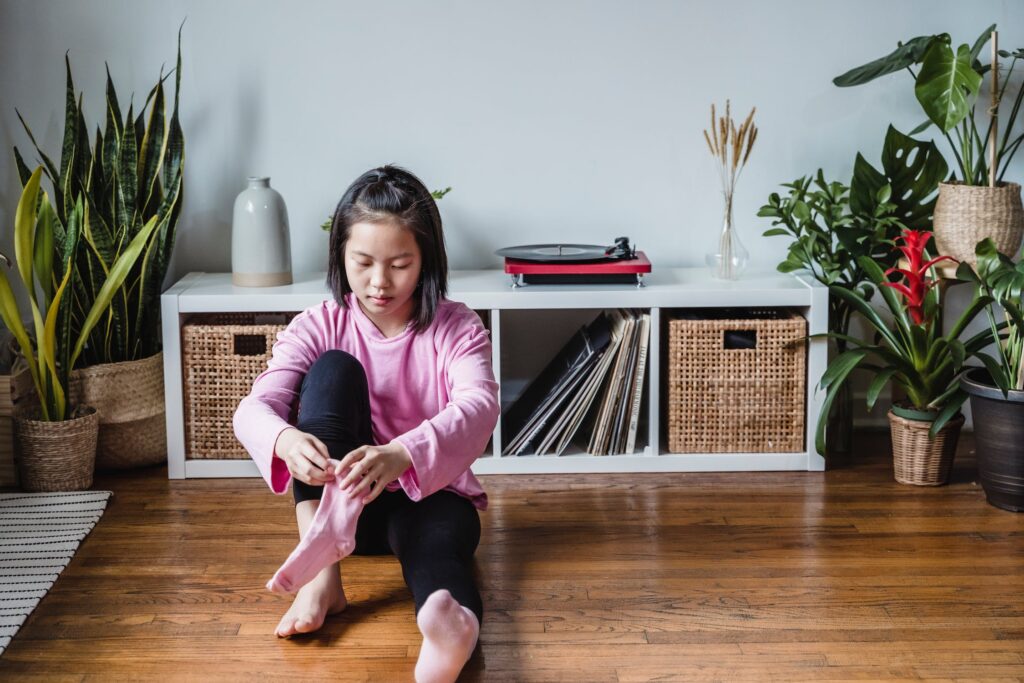Introduction:

Autism spectrum disorder (ASD) is a neurodevelopmental condition that manifests in a variety of ways, affecting an individual’s social skills, communication, and behavior. One common challenge for autistic children is hypersensitivity to clothing, which can make dressing a stressful experience. In this blog, we’ll explore what hypersensitivity to clothing entails and provide practical strategies to help parents and caregivers make this daily routine more comfortable for their autistic children.
What is Hypersensitivity to Clothing?
Hypersensitivity to clothing is a sensory issue commonly experienced by individuals with autism. This heightened sensitivity can lead to discomfort, irritation, or even pain when certain fabrics, seams, tags, or tightness come into contact with the skin. Recognizing and understanding this sensitivity is crucial for finding effective strategies to address it.
1. Comfortable & Easy to Remove Clothing:

Choosing the right clothing is key to managing hypersensitivity. Opt for fabrics that are soft, breathable, and tag-free. Seams and labels can be particularly bothersome, so consider inside-out clothing or tagless options to minimize irritation. Additionally, clothing with flat seams or seamless designs can help reduce discomfort.
Equally important is the ease of removal. Some autistic children may feel trapped or overwhelmed by the sensation of clothing against their skin, making it essential to choose garments that are easy to put on and take off. Elastic waistbands, snaps, or Velcro closures can simplify the dressing process and provide a sense of control for the child.
2. Let Them Choose Their Clothing:

Empowerment and autonomy play significant roles in helping autistic children navigate their sensory sensitivities. Allowing them to have a say in what they wear can make the dressing routine more enjoyable.
Create a wardrobe filled with options that meet their sensory preferences, and encourage them to choose their outfits. This not only fosters independence but also ensures that the clothing selected is more likely to be comfortable for the child.
3. Introduce New Clothing Gradually:

Introducing new clothing can be a delicate process for children with hypersensitivity. Instead of introducing an entirely new wardrobe at once, gradually incorporate new items into their collection. This slow integration allows the child to become accustomed to different textures and styles without overwhelming their sensory system.
Consider incorporating a “sensory preview” by allowing the child to touch and feel the fabric before wearing the new clothing. This step-by-step approach can help reduce anxiety and increase the likelihood of successful acceptance.
4. Reward System for Not Taking off The Clothing:

Positive reinforcement can be a powerful tool in shaping behavior. Implementing a reward system for wearing clothing without taking it off can motivate and reinforce positive habits. Choose rewards that resonate with the child, whether it’s a favorite activity, a small treat, or extra playtime.
Consistency is key in reinforcing this positive behavior. Over time, the child may associate the act of keeping their clothes on with positive experiences, making the dressing routine less stressful for both the child and the caregiver.
5. Be Understanding and Flexible:

Flexibility and understanding are fundamental when supporting autistic children with sensory issues. Recognize that sensory preferences can change, and what works one day may not work the next. Be open to adapting strategies based on the child’s evolving needs and preferences.
Pay attention to cues such as body language, verbal expressions, or signs of discomfort. This attentiveness allows caregivers to respond promptly, making adjustments to the clothing or routine as needed.
Conclusion:
Helping autistic children navigate hypersensitivity to clothing requires patience, understanding, and a tailored approach. By prioritizing comfort, offering choices, introducing new clothing gradually, implementing a reward system, and maintaining flexibility, caregivers can create a positive and supportive environment for dressing routines.
Ultimately, fostering a sense of autonomy and acknowledging individual sensory needs can contribute to a more comfortable and empowering experience for autistic children and their caregivers alike.

